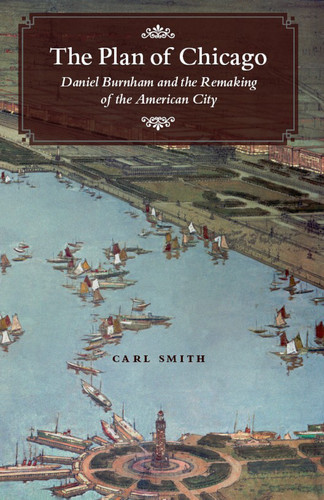Review: The Plan of Chicago by Carl Smith
Reviewed by Robert Duffer

Ninety-eight years ago Daniel Burnham and the Commercial Club of Chicago broadened the perspective of urban planning with the landmark document, The Plan of Chicago. In his latest treatise, Northwestern University professor Carl Smith revisits the keystone that is still referenced by urban planners both in Chicago and elsewhere.
Smith deftly picks apart and illuminates the most compelling parts of the original, of which only 1,650 were originally produced (and sold largely to the business elite). Smith’s storytelling, saturated in engaging fact, gives sharp yet sweeping coverage of how the Plan came to be and how certain parts were laboriously implemented.
In “two short generations,” Chicago had grown from a swampy settlement village to a cosmopolitan metropolis teeming with over 2 million residents. To ameliorate the sprawling city’s rapid and unchecked growth, Burnham, along with Edward H. Bennett and the Commercial Club (“a few dozen individuals in a small private organization”) provided their own capital, initiative and time in envisioning Chicago to become “the most beautiful city in the world.” It was a natural effect that the efforts of the Club’s civic munificence would not only make themselves but every Chicagoan wealthier, in pocket and spirit. The criticism of thinly veiled capitalist avarice couldn’t deter the vision of the man behind The Plan.
Among the many key proposals of the Plan, Smith analyzes three critical parts that represent the revolutionary perspective of the planners: widening and decking Michigan Avenue to extend north of the Chicago River; development of park access and recreational areas along the lakefront and river—all in accordance with Burnham’s belief in the necessary respite that nature provides for urban dwellers; and building around—or in many cases over—the sprawling rail network that owned what would be then and is now Chicago’s most prime real estate.
Smith extends his coverage to how The Plan continues to affect urban planning today. The City Beautiful philosophy has endured in such developments as the Harold Washington Library and the impetus of Millennium Park. The Plan has inspired the Chicago Metropolis 2020, a more ambitious social-equality plan, that incorporates the collar counties.
Look up: Chicago is constantly changing. Smith’s addition to the history and architecture of the city gives fresh perspective on where we’ve been and where we’re going.
Robert Duffer is a regular contributor to Chicago Public Radio’s Eight Forty-Eight, TimeOut Chicago, Chicago Scene and others. Excerpts of his first novel are available on his website, www.robertduffer.com.
